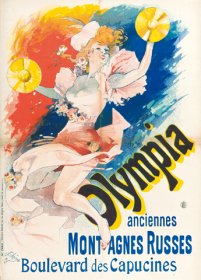
I.1.2
anonym
Depot / d'Eau de Cologne / de Jean-Marie Farina
Frankreich, Paris, 1818
48,5 x 45,0 cm
k.A.
Buchdruck, handkoloriert
DPM 9113

I.3.4
Klimt, Ernst
Internationale / Ausstellung / fuer Musik und Theaterwesen
Österreich, Wien, 1892
Kunstanstalt S. Czeiger, Wien
Farblithographie
120,0 x 88,0 cm
DPM 10974

II.5.2
Mataloni, Giovanni
Incandescenza / a Gas / Brevetto Auer
Italien, Rom, ca. 1898
Institutu Cartographico Italiano, Rom
Farblithographie
148,5 x 100,5 cm
DPM 7900

III.4.2
Kleukens, Friedrich W.
Hessische Landes - Ausstellung / fuer freie und angewandte Kunst / Darmstadt 1908
Deutschland (Deutsches Reich), Darmstadt, 1908
H. Hohmann Hof-, Buch- und Steindruckerei, Darmstadt
Farblithographie
88,3 x 60,2 cm
DPM 4715
An exhibition of the German Poster Museum at the Museum Folkwang
27 January to 25 March 2007
Press conference: 26 January 2007 at 11am
Opening: 26 January 2007 at 7pm
The exhibition is exclusively compiled from the collection of the German Poster Museum, which comprises some 340,000 works. A selection of 288 exhibits, some of which are very rare, document the development of German posters and their forerunners in a European context between 1721 and 1939. Some of these works will be exhibited publicly for the first time.
Hartwig Fischer, the Director of the Museum Folkwang said: "The German Poster Museum owns the largest poster collection in Europe and in its breadth and quality is one of the most important in Germany. We are delighted that within the Museum Folkwang a suitable forum has finally been found for the German Poster Museum, which also ensures the collection’s future." Rene Grohnert, the Director of the German Poster Museum emphasised: "The focus of the presentation is not on the individual poster but on documentation of the genre’s crucial lines of development during the specified time period. The exhibition offers the public an extensive overview of the dynamic development of the poster."
The exhibition is divided into five large sections:
I. Forerunners and Early Posters
This section documents in three groups the early days of the poster. Ances
tors of the poster (leaflets, notices etc.) are shown along with prints
(illustrations, caricatures etc.), which reflect the use of the new medium in the
street environment. The first large-format and coloured sheets (primarily for
indoor use) complete this section.
II. Initial Highlights in the Development of the Poster
France around 1900, posters by Jules Cheret and Henri de Toulouse-Lautrec
amongst others form the first highlight in the development of the poster. The
influence on Germany and other countries was enormous, as examples from Great
Britain, the USA, Belgium and Italy prove.
III. German Posters in the Pre-War Era
Considerably influenced by French, English and Belgian posters, the German
poster at first began to develop differently according to place. Examples from
the turn of the century (19th/20th century) from Hamburg, Dresden, Leipzig,
Krefeld, Duesseldorf and Darmstadt provide an overview. Mainly in Munich and
especially in Berlin an independent and innovative development of the poster
took place from around 1905. This development in turn influenced France and
especially the USA.
IV. Posters in World War I
The posters of the then opposing countries show considerable differences in
tackling the task of canvassing support for the war as well as easing the way
of its socially intolerable consequences. Examples from Germany,
Austria/Hungary, France, England, Italy and the USA show a cross section of the new
poster imagery, which continued after World War I by transforming into political
posters.
V. A New Diversity. Posters from the 1920s and 1930s
The development of the poster is characterised by the almost simultaneous
appearance of opposing visual concepts of development. By using an expressive
imagery posters from the immediate post-war period formulate the new genre of
the political poster. The same applies in culture, especially film.
Bauhaus-influenced design, the "New Typography", the increased use of photography and
photomontage and the spreading of new printing techniques (offset printing)
generated a new type of poster. Simultaneously developments continued in the
areas of Neue Sachlichkeit (New Objectivity) and ornamentation. A final view
is of the following period, documenting posters from the year 1932 and
already auguring the coming era of great historical catastrophes in Europe.
In 2010 the collection of the German Poster Museum Essen, which comprises some 340,000 works, will get its own exhibition space in the then completed new extension to the Museum Folkwang. The exhibition in the Museum Folkwang, which begins on 27 January 2007, is a foretaste of a groundbreaking new presentation of the collection of the German Poster Museum in one of the major venues in the Ruhr area.
The exhibition is accompanied by a catalogue with contributions by Bernhard Denscher, Juergen Doering, Rene Grohnert, Lars Herzog-Wodtke, Anita Kuehnel, Hellmut Rademacher, Bettina Richter and Dieter Vorsteher, published by Hermann-Schmidt-Verlag, Mainz, at a price of € 29,80 (museum edition).
Opening times:
Tuesday – Sunday 10am – 6pm
Friday until midnight
Closed on Mondays
Entrance fee: 5 €
Visitor information/Guided Tours:
0201-8845 301 / 8845 314
Press contact: Hendrik von Boxberg, 0201-8845 160,
presse@museum-folkwang.essen.de

I.2.5
Doerbeck, Franz Burchard
Berliner Redensarten: / Oh! Bange machen gelt nich!
Deutschland (Deutsches Reich), Berlin, vor 1835
k.A.
Lithographie, handkoloriert
18,3 x 13,3 cm
DPM 7947

II.1.6
Cheret, Jules
Olympia / anciennes / Montagnes Russes / Boulevard des Capucines
Frankreich, Paris, 1892
Imprimerie Chaix, Paris
Farblithographie
123,0 x 88,0 cm
DPM 10843

IV.2.1
Geyer, Rudolf
Unsere Armee braucht / Metalle! / Kriegsmetall-Einkauf
Österreich, 1915
Christoph Reisser's Soehne, Wien
Farblithographie
126,0 x 95,0 cm
DPM 10891

V.3.6
Tschichold, Jan
Nacht der Liebe (Two Lovers)
Deutschland (Deutsches Reich), Muenchen, 1928
Kunst im Druck, Muenchen
Buchdruck
120,5 x 84,5 cm
DPM 9810